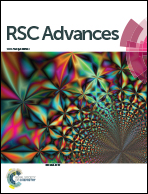Design and synthesis of supramolecular functional monomers bearing urea and norbornene motifs†
Abstract
Three sets of functional monomers namely urea-based, 2-ureido-4[1H]-primidone (UPy)-based and norbornene based functional monomers were designed and synthesized. These functional monomers (FM) were obtained in decent yields using amine and isocyanate/norbornene as starting materials. Methacrylate and styrene isocyanate with 1,4-diaminobutane/tris(2-aminoethyl)amine were chosen for the synthesis of symmetrical, asymmetrical and three-branched urea-functional monomers, respectively. UPy-based FMs were synthesized with isocyanate and 2-amino-4-hydroxy-6-methylpyrimidine. The synthesis of these monomers feature short reaction times, mild reaction conditions and no need for column chromatographic purification. Furthermore, the norbornene based FM was used for preparing molecularly imprinted polymers (MIPs) by Ring-Opening Metathesis Polymerization (ROMP). Results showed that these synthetic routes represent a convenient and useful approach for synthesis of novel functional monomers.

- This article is part of the themed collection: Editors' collection: Supramolecular Polymers


 Please wait while we load your content...
Please wait while we load your content...